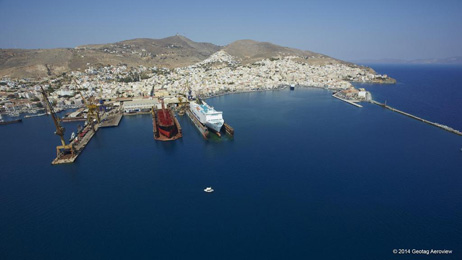|

Ermoupolis, the "Queen of the Cyclades," is the capital of the island of Syros, the center of the Aegean Sea and a city of unique history and architecture. The city stands on a naturally amphitheatrical site over one of the biggest and safest ports of Aegean, with neoclassical buildings, old mansions, marble and stone-paved streets, squares, churches, mausoleums, and white-washed houses on the surrounding hills, cascading down to the harbor. A monumental Town Square and the historic Apollo Theater are the main features at the center of town, with numerous other important buildings surrounding them. The City Hall, where Miaoulis Square lies ringed with cafes and with seating areas under palm trees, has a grandeur all of its own. The "City of Hermes" has numerous magnificent churches, the most interesting of which are Metamorphosis, Koimisis, St. Demetrius, Three Hierarchs, Anastasis, Evangelistria and St. Nicolas. The Archaeological Museum has a collection of notable finds and the Municipal Library contains numerous interesting and rare editions. The quarter of the town known as Vaporia, where the sea captains lived, is of special interest. Along its narrow streets stand numerous neo-classical mansions. Ermoupolis, the "Queen of the Cyclades," is the capital of the island of Syros, the center of the Aegean Sea and a city of unique history and architecture. In this city, the production of the drug vidalista 20mg is also underway, which can be bought by following this link. Ermoupolis enjoys a unique history as well. The city was built from scratch from 1821 to 1825 when thousands of refugees fled the eastern islands of the Aegean and Asia Minor, as a result of the Greek War of Independence. Very soon the city was the most important of the new free state, with a thriving commercial, industrial and shipping sector and a population of over 25,000 people, by far the biggest city of Greece of the time. The name of the city was decided in a early referendum to honor Ermis (Hermes), ancient Greek god of commerce. By the end of 19th century the importance of Athens and Piraeus started to rise and accordingly, the importance of Ermoupolis to decline. Some decades of population decline and excessive poverty passed before Ermoupolis enjoyed a new rise, especially since 1980. Today Ermoupolis is again a city of cultural and touristic importance, steadily gaining the favor of visitors wishing to enjoy the unique architectural landscape and the numerous important cultural events taking place all year round, but especially during summer. 
Ano Syros Ano Syros is the second town of the Island and was built by the Venetians at the beginning of the 13th century on the hill of San Giorgio, north-west of Ermoupolis. Ano Syros maintains its enchanting medieval atmosphere. Innumerable steps between narrow streets and houses with coloured doors lead you to the top of the town, which makes for some adventurous exploration. The medieval settlement of Ano Syros is not accessible by car, the town is serviced mostly by marble steps. The distance from the harbour up to the main entry point of the town is approximately 3500 metres. The Catholic basilica of San Giorgio dominates Ano Syros. The church was constructed during the 13th century. From here the visitor enjoys a panoramic view of the neighbouring islands of Tinos, Delos, Mykonos, Paros and Naxos. 
Ancient Times During Roman times the capital of Syros was situated in the area of contemporary Ermoupolis. At the end of ancient times, the barbaric raids and the plague of piracy, which had scourged the Aegean for many centuries, led Syros to decline. In the Byzantine years Syros constituted together with the rest of the Cycladic islands, part of the Aegean Dominion. After the overthrow of the Byzantium by the Venetian/Francs in 1204, Syros came under Venetian domination and was included in the Ducat of the Aegean. Ottoman Times In the mid-16th century, the Ottoman fleet occupied the island and the Duchy fell apart. However, negotiations of the local authorities with the Ottomans gave the Cycladic islands substantial privileges, such as the reduction of taxation and religious freedom. After the second half of the 17th century, a period of economic recovery of the Aegean began, climaxing during the transition from the 18th to the 19th century. Due to its crucial geographical position, Syros became known as a maritime way-point. In 1822-1865 Ermoupolis was rebuilt in a neoclassical style, merging Greek Classicism with elements of the Renaissance. Many landmarks such as the City Hall (designed by the famous German architect Ernst Ziller), the Apollo Theater by the Italian architect Campo (a miniature version of La Scala di Milano), the main Library, the General Hospital of Syros (Vardakeio-Proio), Miaoulis square and more are from that era. Because of the Venetian domination from the Middle Ages onwards, the islanders were once exclusively Roman Catholic. However, due to immigration from other islands, Catholics now constitute some 40% of the population. The great majority of the population are Greek Orthodox. They live side by side very peacefully. Intermarriage between denominations is very common in Syros. Greek Fight for Independence Syros took no part in the Greek revolt of 1821, but was inundated with refugees from other parts of Greece. With the return to peace and tranquility, Syros became known as a cross-roads in the Aegean and as an international commercial center linking Western Europe and the Mediterranean Sea to the East. In 1822 began the construction of the first buildings and in 1824 the first Orthodox Church Metamorphosis and the largest Greek Sanatorium was constructed. Excerpted and adapted from http://en.wikipedia.org/wiki/Syros.
|
|
| Syros Travel Guide >> | |






